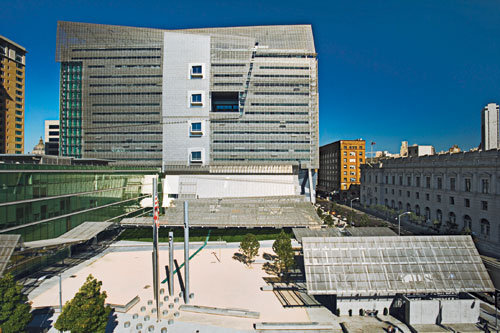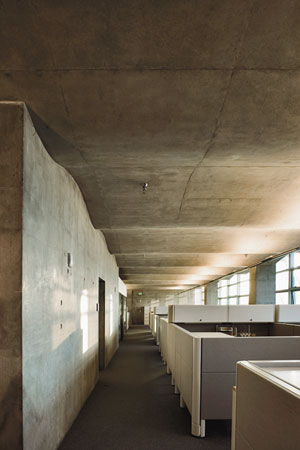Core Values
More Than Skin Deep
Several engineers commented that high profile architects sometimes design eccentric buildings that often belie awkward and material intensive structures beneath their sleek skins. But the L.A. firm Morphosis manages to mix green practices with cutting-edge design. The San Francisco Federal Building, completed in 2007, provides a good case study for the integration of structure into sustainable strategies of a building. “Our approach is to look at how all systems can be integrated to enhance the performance of the building on a number of different levels,” says Brandon Welling, project architect for the facility. “From the beginning of the schematic design process we brought in all the engineers because we wanted to set up a model of integration,” he adds.
The design team used a narrow floor plate for the 18-story building, which accommodates cross ventilation from the prevailing winds. Instead of hanging girder beams down from the floor, the engineers at Arup helped develop a system of upturned concrete beams that run the long direction of the tower. Above the slab, the beams are enveloped within the raised floor system. The upturned beams free the ceiling of obstructions and allow ventilation air to move uninterrupted across the thermal mass of the exposed concrete. The team wanted to use thermal mass to absorb heat during the day, and night flush ventilation to cool it at night. In lieu of using beams for the short dimension of the structure, the engineers helped to develop a wave-formed slab that functions as a stiffened corrugated plate. The corrugations not only channel the air through the building, they increase the surface area and the thermal storage capacity of the slab. Because of the passive strategies, the top 12 floors have only minimal mechanical systems in the upper lobbies, according to Welling.
The Durable and Adaptable Building
Though we live in the era of the 50-year building, the U.S. General Services Administration requires its facilities to be built for a 100-year lifespan. That was the case for the San Francisco Federal Building. Engineers are often pushed by the marketplace to design structures that are as cost-effective to build and as materially efficient as possible for an intended purpose and life span. Structural efficiency can also be seen as a green strategy: Using fewer materials reduces the amount of energy it takes to construct a building as well as the embodied energy and carbon in a structure. At the cutting edge of structural efficiency are evolutionary optimization programs whose software is a kind of digital version of the natural selection process. It quickly generates multiple iterations of possible structural variations responding to conditions such as load patterns. Skidmore, Owings & Merrill (SOM) used evolutionary optimization software to develop the structure for the tallest building in the world, the Burj Khalifa in Dubai. Interestingly, these structures often evolve into non-rectilinear forms that echo structures found in nature.
 |
In the San Francisco Federal Building, a wave-form slab supports the floor plate and provides thermal mass. Photo © Nic Lehoux |
 |
The upturned beams keep the undulating ceiling plane free of structure and allow ventilation of the thermal mass. Photo © Nic Lehoux |
However, the counterpoint to extreme structural efficiency is that sustainable buildings should be built for longevity by making them durable and adaptable to future uses. Extending a building's life can save much of its embodied energy and eliminate the enormous amount of energy and resources spent in replacing it.
When considering the longevity of the San Francisco Federal Building, the design team took into account how the structure would adapt to change. Besides optimizing ventilation and daylighting, the narrow floor plate allowed the designers to use perimeter columns only, which left the interior free of structure. The lack of fixed obstructions is a key aspect of a flexible and adaptable space.
Stewart Brand's book How Buildings Learn has been influential in developing concepts of building adaptability. Brand promoted the idea of shearing layers, in which building elements are replaced at different rates of time. Layers such as interior finishes and “stuff” (furniture, equipment, etc.) are replaced relatively frequently, whereas the structure has a longer lifespan. “We start envisioning buildings as being skeleton and skin and try to get the skeleton to be straightforward and robust,” says David Mar, a principal at Tipping Mar. “We see programming and architectural partitions as temporary,” he adds.
Instead of hiding small shear walls within partition walls, Mar advocates the use of a few strong frames such as steel or concrete rocking frames. “The goal is to make buildings more flexible for future incarnations,” he says.
Determining the balance between durability and efficiency requires the design team to weigh a myriad of factors, including the lifespan of the structure and potential future uses. One aspect to consider is the general building type. Lance Hosey divides buildings into two general categories: figural and fabric buildings. “Fabric buildings make up the consistent aesthetic of the city, such as housing and commercial. For fabric buildings we should be creating structures that are as flexible as possible,” Hosey says. “Figural buildings, such as churches, museums, and civic buildings, tend to keep their function. The Louvre, for example, has been a museum for half a millennium. We can push the [efficiency] envelope in how we shape the structure for buildings that are likely to keep a specific function,” he adds.









